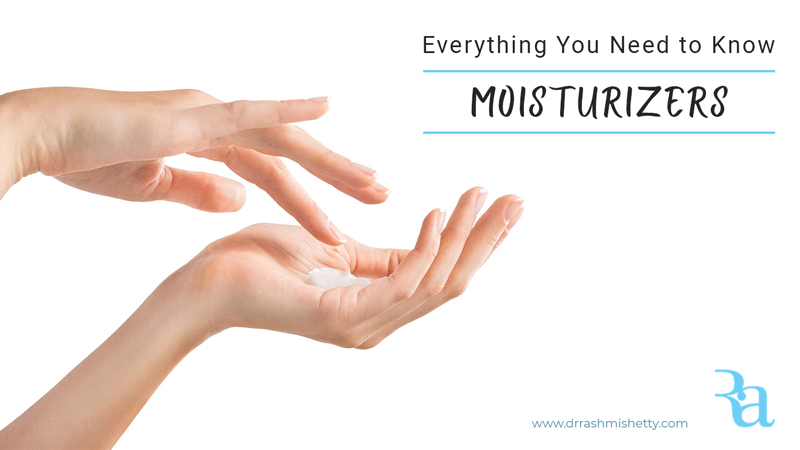Everything You Need to Know About Moisturizers
We have all learned since middle school science classes that the majority of our body weight is water. Similarly, our skin is about 64% to 70% of water, most of which remains in the epidermis. However, that water content keeps on changing depending on –
- Age
- Gender
- Climate
- Skin type
The water from the deeper layers of the skin keeps on evaporating into the air without you even realizing. This is known as transepidermal water loss. The most basic job of a moisturizer is to trap the escaping water and keep it within your skin, thereby, maintaining optimum hydration.
A moisturizer is made out of 3 main ingredients –
Occlusive
: these ingredients form a thin, waxy coating on the surface of skin which prevents water loss effectively. Some of the most widely used and effective emollients used in moisturizers are–
- Petroleum jelly
- Castor oil
- Cetyl alcohol
- Stearyl alcohol
- Cocoa butter
- Lanolin
- Mineral oil
Humectants:
these are water-loving ingredients which can suck water from the environment or the deeper layers of the skin and infuse it in the top stratum corneum layer of the skin. Thus, keeping the skin looking plump and supple. Some best humectants that you can find readily in moisturizers are –
- Hyaluronic acid
- Glycerine
- Propylene Glycol
- Panthenol
- Honey
Emollient:
Emollients are rich in lipids which fill in microscopic cracks and spaces between the cells in the skin to soften and smoothen dry, rough and flaky skin. Some of the commonly used emollients are –
- Dimethicone
- Triglycerides
- Squalane
- Ceramide
Skin types
Skin can be classified into 4 different types depending on the natural sebum production –
Dry: It lacks moisture because of slow and low secretion of sebum. This results in tightness, flakiness and cracking of the skin. Dullness often accompanies dry skin.
Oily: There is an overproduction of sebum creating a greasy, sticky and shiny film on the skin. Oily skin can be dehydrated from the inside. It is often accompanied with clogged pores and acne.
Combination: Some regions of the face are dry while others are oily. The t-zone region is usually oily with dry cheeks in this skin type.
Normal: The sebum production and hydration level in the skin are well balanced. Thus, giving the skin a healthy glow and smooth texture.
Skin type can change due to –
Age: Adolescence is characterized by an overproduction of sebum leading to acne; whereas the sebum production comes down dramatically as one age leading to dry skin.
Climatic conditions: dry air during the wintertime has a tendency to suck out a lot of moisture from your skin, making it dry and flaky. But, as summer and monsoon approaches, the humidity is high in the air, thereby making your skin feel greasy and sticky, turning it into an oily skin type.
Hormonal changes: Hormonal changes due to medication, stress and age are notorious for turning skin oily.
Fad diets: People often follow strict diets to shed those extra pounds, which cuts down fats from their diets completely. This includes the good fats which are responsible for keeping your skin and hair soft, supple and shiny. As a result, your skin becomes dry.
Wrong skincare: oily skinned beauties often use very harsh products, especially cleansers, which strip off every trace of oil from the skin. And, then skip moisturizers. This definitely gives the satisfaction of matte skin but only for a couple of hours at best. On sensing the dryness, the skin overproduces oil, and the face turns into a grease ball eventually. On the other hand, over-exfoliation of the skin can damage the skin barrier making is dry.
The perfect moisturizer for the different skin types
Dry skin: If you have dry skin then your goal is to repair and nourish the protective barrier of the skin so the skin can retain moisture within its layers. It would be best if you had richer, thicker products which can make up for the lack of natural sebum on your skin. Oil-based creams which have a handsome amount of emollient and occlusive ingredients in it are great for your skin type.
Oily skin: Oily skin usually lacks hydration. So, you need products that are water-based gels that are a super lightweight on your skin. Get’s absorbed readily. And, supplies your skin with a lot of water. It would be best if you looked for moisturizers that are rich in humectants. You may even get away by applying a humectants rich serum while the natural sebum on your skin will do the job of locking in that moisture.
Combination skin: One has to keep in mind that this is a rather tricky skin to handle. Your skincare regimen can definitely benefit from using two different moisturizers at the same time. Apply a gel-based, humectants rich moisturizer all over the face first. Then, follow it up with a richer cream only on the areas of dryness.
Normal skin: Normal skin tends to get extra oily during the sultry months of the years. So, this is when it needs a good gel-based moisturizer to retain good hydration even with all the sweating and sun exposure. However, you’ll need a richer moisturizer during the colder months when your skin turns drier than usual.
AM and PM moisturizer
Day Cream: During the day, your skin faces a lot of environmental damage, rigorous activity and pollution. So suffocating it with a thick layer of rich moisturizer is definitely not a smart idea. Moreover, the stickiness on your skin attracts more dust and grime during the day. So, a lightweight moisturized that completely sinks into your skin is the need of this hour. It will give you enough hydration and protection from the surroundings.
Night Cream: Your skin goes into ultra repair mode during the night-time. This is also the time when water loss is at its peak, especially if you are sleeping in an air-conditioned room. This is when your skin needs a rich nourishing moisturizer that can not only lock moisture into your skin but also provide it with essential nutrients for it to absorb.
Dr. Shetty’s Recommendations
- If you have dry skin, it is best to layer products. You can start with a mist on clean skin. A hydrating serum can come next. Lock the goodness with a rich moisturizer and finally top it off with a sunscreen during the day.
- For my beauties with oily skin, I would recommend less layering. You may start with a good, non-alcoholic toner. Use a light moisturizer and finish it with a gel sunscreen.
Care at Ra Clinic
- Chemical peels and mechanical exfoliation: This gentle exfoliation of the top layer of dead skin results in better penetration of the moisturizers you put on your skin.
- Hydrating facial: You can see instant plumpness in your dry skin with this beautiful facial designed for dry skin.
- Illuminating facial: Get a beautiful moisturized glow on your face and say goodbye to dry dullness with this facial.
- Clean up: See the gunk get out of your pores, and it will breathe in freshness to your oily clogged skin.
- Hydra facial: The perfect facial for combination skin to give it just the right amount of clean up and nourishment at the same time.
- Pologen facial: Maintain and nourish your normal skin with this beautiful facial that will leave you with smoother, brighter skin.
- The skin nourishment program: Every skin type needs the right nutrients to maintain its healthy glow. Our skin nourishment program is absolutely life transforming in this regard.
Ra Range of Recommended Supplements from Solskin:
Ra Skin Hydrate Tablet: This capsule is a potent blend of essential nutrients like sodium hyaluronate, collagen peptide, alpha hydroxyl acid and many more. When your body absorbs these essential nutrients, your skin is repaired from within. You will see reinvigorated plumpness, brightness and glow on your skin and dryness will be a thing of past.
PrimeRose+: The efficient combination of evening primrose oil, vitamin e and flaxseed oil in this beautiful capsule makes it a magical remedy for restoring the health of your dry skin. The essential fatty acids of this powerful blend keep your skin deeply moisturized and glowing from within.
If skincare interests you and you want to learn more things to make your skin look and feel better, then follow
Dr. Rashmi Shetty Instagram handle @drrashmishettyra.
Dr. Shetty posts very interesting things about everything related to skin.













Leave a Reply
Want to join the discussion?Feel free to contribute!